
Lycaenidae is the second-largest family of butterflies, with over 6,000 species worldwide, whose members are also called gossamer-winged butterflies. They constitute about 30% of the known butterfly species.

Riodinidae is the family of metalmark butterflies. The common name "metalmarks" refers to the small, metallic-looking spots commonly found on their wings. The 1,532 species are placed in 146 genera. Although mostly Neotropical in distribution, the family is also represented both in the Nearctic, Palearctic, Australasian (Dicallaneura), Afrotropic, and Indomalayan realms.

The chalkhill blue is a butterfly in the family Lycaenidae. It is a small butterfly that can be found throughout the Palearctic realm, where it occurs primarily in grasslands rich in chalk. Males have a pale blue colour, while females are brown. Both have chequered fringes around their wings.

Miletus is a genus of butterflies sometimes called brownies. Its species are found in the eastern Palearctic realm and the Indomalayan realm, and some stray east of the Wallace Line. The genus was erected by Jacob Hübner around 1819. Miletus is the type genus of the subfamily Miletinae.
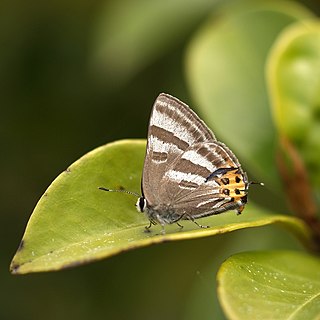
The Deudorigini are a tribe of butterflies in the family Lycaenidae.

George Thomas Bethune-Baker was an English entomologist who specialised in Lepidoptera, especially those in the family Lycaenidae of butterflies.

Feniseca tarquinius, the harvester, is a butterfly of the family Lycaenidae, and the only member of the monotypic genus Feniseca. It is found in eastern North America.

Philiris is a genus of butterflies in the family Lycaenidae. The species of this genus are found in the Australasian realm, mostly inhabiting tropical rainforests. Philiris was erected by Julius Röber in 1891. It is a speciose genus. Tite decided on 56 species. Sands added 11 species and placed the taxa into 21 species groups. Most species are on New Guinea. Tite considered Philiris and Candalides Hübner, 1819 to be sisters. Eliot (1973) placed Philiris in Luciini Waterhouse & Lyell, 1914, close to Hypochrysops C. et R. Felder, 1860. Compared to other members of the tribe, Philiris have relatively uniform ventral patterns with usually silvery-white ground color.
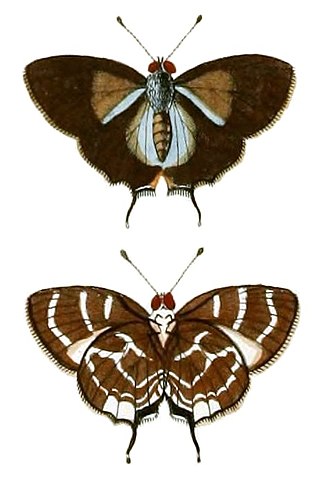
Thereus is a genus of gossamer-winged butterflies. Among these, it belongs belong to the tribe Eumaeini of the subfamily Theclinae. These small butterflies occur essentially all over the Neotropics.
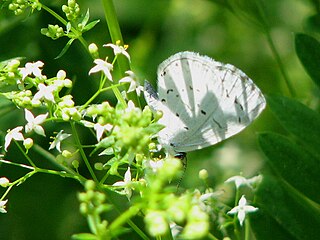
Celastrina serotina, the cherry gall azure, is a butterfly of the family Lycaenidae. It is found across North America as far north as the treeline. Its flight time is between mid-May and mid-June in eastern Ontario after the spring azure and before the summer azure. The larva has been reported to feed on galls of eriophyid mites and apparently also on the mites themselves, making them one of the rare species of carnivorous Lepidoptera. It is commonly found around woodland roads of upland mixed deciduous hardwood forests which are surrounded by wetlands.

Satyrium edwardsii, the Edwards' hairstreak, is a species of butterfly in the family Lycaenidae. It is found in the eastern parts of the United States and in the southern parts of the Canadian provinces from Saskatchewan to Quebec.
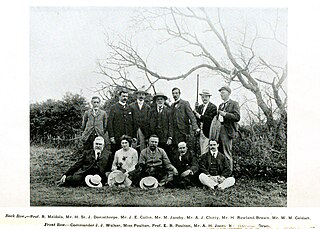
Hamilton Herbert Charles James Druce was an English entomologist who specialised in Lycaenidae and to a lesser extent Hesperiidae. He is not to be confused with his father, the English entomologist Herbert Druce (1846–1913) who also worked on Lepidoptera.

Deudorix livia, the pomegranate playboy, is a butterfly in the family Lycaenidae. It is found in Senegal, the Gambia, Burkina Faso, Cameroon, Chad, Sudan, Uganda, Kenya, Tanzania, Somalia, Djibouti, Yemen, Saudi Arabia, United Arab Emirates, Oman, Algeria, Egypt and the eastern Mediterranean, including Greece. The habitat consists of savanna, including arid savanna.
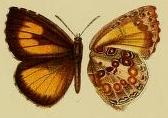
Lachnocnema luna, or Druce's large woolly legs, is a butterfly in the family Lycaenidae. The species was first described by Hamilton Herbert Druce in 1910. It is found in Ghana, eastern Nigeria, Cameroon, Gabon, the Republic of the Congo, the north-eastern part of the Democratic Republic of the Congo, Uganda and north-western Tanzania. The habitat consists of forests.

Thereus orasus is a species of butterfly of the family Lycaenidae. It occurs in montane habitats from central Mexico to those of western Panama (Chiriquí) at elevations from 1,100 to 1,800 meters.

Thereus lomalarga is a species of butterfly of the family Lycaenidae. It is found from Costa Rica to the western slope of the Andes in Ecuador. It occurs in the great variety of forested habitats.

Thereus oppia is a species of butterfly of the family Lycaenidae. It is found from Mexico to Costa Rica at a variety of elevations. Most localities where it occurs appear to be deciduous dry forest.

Thereus pedusa is a species of butterfly of the family Lycaenidae. It is found in Brazil (Amazon) and the Guianas.

Thereus pedusa is a species of butterfly of the family Lycaenidae. It is found from Nicaragua to Brazil and Suriname.

















